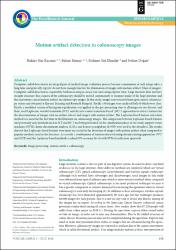| dc.contributor.author | Yılmaz, Bülent | |
| dc.contributor.author | Kaçmaz, Rukiye Nur | |
| dc.contributor.author | Dündar, Mehmet Sait | |
| dc.contributor.author | Doğan, Serkan | |
| dc.date.accessioned | 2019-04-30T06:23:17Z | |
| dc.date.available | 2019-04-30T06:23:17Z | |
| dc.date.issued | 2018 | en_US |
| dc.identifier.other | DOI: 10.2478/ebtj-2018-0022 | |
| dc.identifier.uri | http://acikerisim.agu.edu.tr/xmlui/handle/20.500.12573/4 | |
| dc.description.abstract | Computer-aided detection is an integral part of medical image evaluation process because examination of each image takes a long time and generally experts’ do not have enough time for the elimination of images with motion artifact (blurred images). Computer-aided detection is required for both increasing accuracy rate and saving experts’ time. Large intestine does not have straight structure thus camera of the colonoscopy should be moved continuously to examine inside of the large intestine and this movement causes motion artifact on colonoscopy images. In this study, images were selected from open-source colonoscopy videos and obtained at Kayseri Training and Research Hospital. Totally 100 images were analyzed half of which were clear. Firstly, a modified version of histogram equalization was applied in the pre-processing step to all images in our dataset, and then, used Laplacian, wavelet transform (WT), and discrete cosine transform-based (DCT) approaches to extract features for the discrimination of images with no artifact (clear) and images with motion artifact. The Laplacian-based feature extraction method was used for the first time in the literature on colonoscopy images. The comparison between Laplacian-based features and previously used methods such as WT and DCT has been performed. In the classification phase of our study, support vector machines (SVM), linear discriminant analysis (LDA), and k nearest neighbors (k-NN) were used as the classifiers. The results showed that Laplacian-based features were more successful in the detection of images with motion artifact when compared to popular methods used in the literature. As a result, a combination of features extracted using already existing approaches (WT and DCT) and the Laplacian-based methods reached 85% accuracy levels with SVM classification approach. | en_US |
| dc.description.sponsorship | Turkish Higher Education Council's 100/2000 Program | |
| dc.language.iso | eng | en_US |
| dc.publisher | The EuroBiotech Journal | en_US |
| dc.relation.ispartofseries | Volume 2;Issue 3 | |
| dc.rights | info:eu-repo/semantics/openAccess | en_US |
| dc.subject | Image processing | en_US |
| dc.subject | motion-artifact | en_US |
| dc.subject | colonoscopy | en_US |
| dc.title | Motion artifact detection in colonoscopy images | en_US |
| dc.type | article | en_US |
| dc.contributor.department | AGÜ, Mühendislik Fakültesi, Elektrik & Elektronik Mühendisliği Bölümü | en_US |
| dc.contributor.institutionauthor | | |
| dc.identifier.doi | 10.2478/ebtj-2018-0022 | |
| dc.relation.publicationcategory | Makale - Uluslararası Hakemli Dergi - Kurum Öğretim Elemanı | en_US |


















